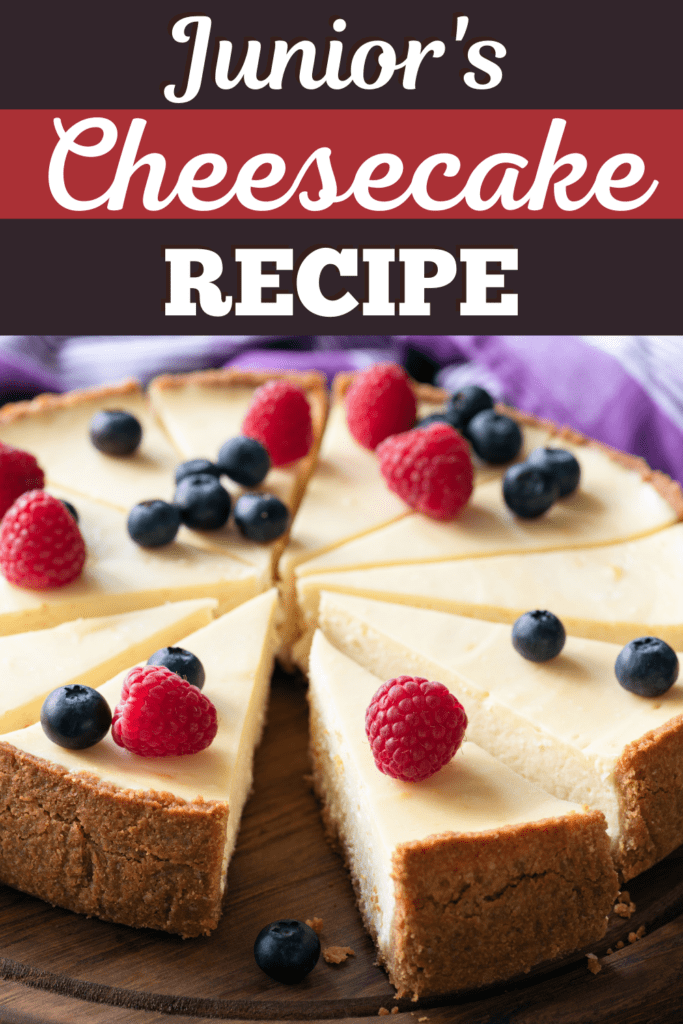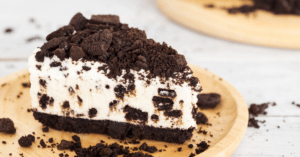This Junior’s cheesecake recipe is the best way to get that signature NYC taste at home!
Junior’s Cheesecake has been making its signature New York cheesecake since the 1950s.
There are several kinds of cheesecake in the world, but if you ask me, New York cheesecake is the one to beat. It’s sinfully rich, dense, and oh-so-decadent!

And if you’re from New York, you know that Junior’s is the go-to place for cheesecake.
With its unique combination of light and airy sponge cake “crust” and an ultra-smooth and silky cheesecake filling, Junior’s cheesecake is truly a work of art.
What better way to impress your friends with your baking skills than by making them the “World’s Most Fabulous Cheesecake?” Let’s get the show started!
Junior’s Cheesecake Recipe
Every New Yorker will argue that Junior’s cheesecake is the best cheesecake in the world. The cheesecake is smooth, velvety, and insanely rich and creamy.
What sets it apart from other cheesecakes, in my opinion, is the layer of sponge cake underneath.
The light and airy consistency is a wonderful contrast to the dense cheesecake. Together, they create the perfect balance.
I won’t lie to you: this cake requires a lot of work. Because you’ll essentially make two cakes – a sponge and a cheesecake – there are a handful of steps to go through.
You’ll also need to be very patient, as it needs a few hours to cool and set before you get to eat it.
But don’t worry, because as long as you follow the instructions to a tee, you’ll be fine! Also, believe me, all that hard work is worth the effort.
Ingredients
Sponge Cake
- Cake Flour. The base of the cake. Cake flour ensures the cake is super light and airy. If you don’t have it on hand, make it yourself! Place a cup of all-purpose flour in a bowl. Take out 4 teaspoons and replace them with cornstarch. Sift the mixture twice, and voila.
- Baking Powder. The leavening agent that will make the sponge cake rise.
- Salt. For flavor enhancement.
- Eggs. Separate the yolks from the whites. Beat the egg whites to get that light and airy cake consistency.
- Granulated Sugar. For sweetness.
- Vanilla and Lemon Extracts. To flavor the cake.
- Butter, Melted. For richness.
- Cream Of Tartar. To help stabilize the egg whites.
Cream Cheese Filling
- Cream Cheese. Use brick cheese for a firmer consistency. Use full-fat for full flavor – now is not the time to worry about calories. Last, use softened, room-temperature cream cheese for a smooth and silky filling.
- Sugar. To sweeten and balance out the tangy cream cheese.
- Cornstarch. To help the cheesecake set.
- Vanilla Extract. Just a bit to enhance flavor.
- Eggs. For binding the ingredients together, giving the batter structure.
- Heavy Whipping Cream. The key to a ridiculously smooth and creamy New York cheesecake.
Tips for the Best Cheesecake
- Cheesecakes in general taste better the next day. They need a few hours for the flavors to marry. If you don’t give them time to set, they’ll taste a little eggy.
- Use room-temperature eggs so that the ingredients incorporate easily with one another.
- Do not underestimate the importance of a water batch. Cheesecake is like a delicate custard. It has to cook slowly, otherwise, it will crack, curdle, or darken. The water bath technique regulates the temperature of the oven, ensuring that the cake doesn’t cook too fast.
- Be sure the sponge cake is completely cooled before adding the cream cheese filling. Otherwise, you might tear the cake apart!
- You can make the sponge cake up to a day in advance. Cover it with plastic wrap and store it at room temperature.
- To ensure clean slices, run the knife under hot water and dry with a paper towel. Wipe the knife with a paper towel in between slicing.
- Topping suggestions:
- Shaved chocolate
- Fresh fruit
- Fruit compote
- Chocolate or caramel sauce
- Lemon curd
- Crushed candy
- To remove the cake from the bottom of the spring-form pan easily, freeze it for 30 minutes. Gently slide it onto the serving cake with a 12-inch metal cake spatula. If you don’t have one, it’s fine, you can just transfer the cake onto the serving dish with the pan.
- Cover leftover cheesecake in plastic wrap and refrigerate for up to 5 days.
- You can also freeze the cheesecake for up to 6 months. Wrap each slice with plastic wrap and foil and place them in freezer-safe bags. Thaw in the fridge overnight.

How Is This New York Style Cheesecake Different?
New York cheesecakes are much firmer, denser, and richer than other cheesecakes. This one is so thick that it almost sticks to the roof of your mouth.
The secret? A lot of cream cheese, heavy cream, and eggs.
Junior’s cheesecake is also quite unique in that it doesn’t come with the usual graham cracker crumb crust.
At the bottom of the cheesecake is a thin layer of fluffy sponge cake that offers a nice texture contrast to the silky cream cheese filling.
Why Did My Cheesecake Crack?
First of all, if this does happen, don’t panic. A cracked cheesecake tastes just as good as a perfectly smooth one.
Plus, if you’re really bothered by it, you can always cover it up with toppings.
There are several factors that could lead to a cracked cheesecake. If you want to avoid it next time, here are a few tips:
- Beat the ingredients at low speed. Over-beating the ingredients will incorporate air into the batter, which may cause cracks.
- Do not overcook the cheesecake. This is the most common culprit for cracked cheesecakes. The best way to check for doneness is by using an instant-read thermometer, which should read 150 degrees Fahrenheit.
If you don’t have an instant-read thermometer, give the pan a little shake. The cake should still be jiggly in the center. Don’t worry, it will continue to bake as it cools.
- Do not open the oven door during baking. Cheesecake hates changes in temperature.
- Do not refrigerate the cake right away in an attempt to cool it faster. Let it cool on the wire rack for an hour before you pop it in the fridge.
More Amazing Cheesecake Recipes
Cheesecake Brownies
Double-Layer Pumpkin Cheesecake
Philadelphia No-Bake Cheesecake











